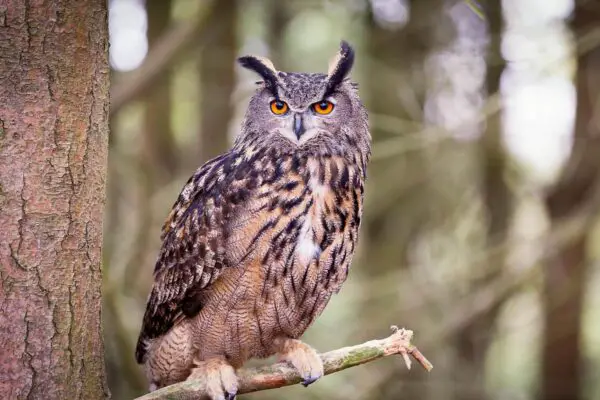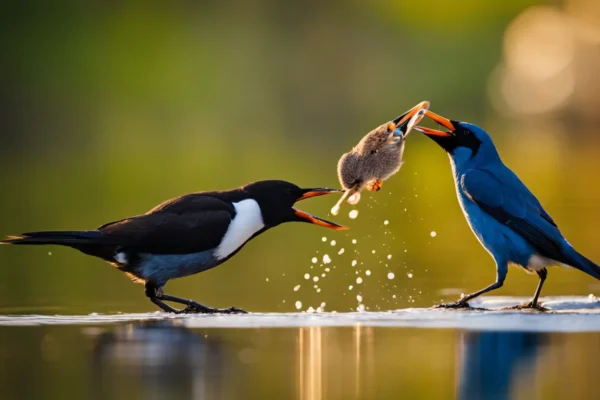It’s amazing to see newborn birds hatch and develop in their nests day by day as spring comes. You may be wondering how long those tiny, featherless hatchlings need to mature before leaving the nest if you’ve noticed one in your yard.
Here’s a fast response if you’re pressed for time: most songbird fledglings depart the nest within two to three weeks. It may take 8–14 weeks for larger birds, such as raptors. The precise time varies on variables such as the species and quantity of offspring.
This comprehensive book covers the whole life cycle of a newborn bird, from hatching to fledging. You’ll discover developmental phases, variations according to the location of the nest, and advice on how to prevent invading nests too soon.
Hatchling Developmental Stages of Baby Birds
Hatchlings are young birds that have just hatched. They are totally reliant on their parents at this point for warmth, nourishment, and safety. With their eyes closed and little to no feathers, hatchlings are often tiny and delicate.
As they wait for their parents to bring them food, they spend the majority of their time in the nest.
It is noteworthy that not every young bird hatches at the same moment. Certain species, such as geese and ducks, are known as precocial, meaning they may leave the nest soon after birth and are born with their eyes open.
Altricial species, on the other hand, like songbirds, are born defenseless and need longer time in the nest before they can fly.
Nestlings
Baby birds go through the nestling stage as they mature. Their eyes open and their bodies start to grow feathers during this period. As they get more energetic, nestlings may begin to explore the nest and try their legs and wings.
They still depend on their parents, nevertheless, for safety and sustenance. In order to assist the nestlings’ quick development, the parents keep bringing food to the nest. The nestlings are fed a diet rich in protein and minerals.
Seeing the interactions between nestlings and their parents is amazing. Because the bigger and stronger nestlings may fight with one another for more food, sibling rivalry may sometimes be seen. On the other hand, the parents make an effort to provide equal attention and sustenance for each fledgling.
Newbies
For young birds, the fledgling period is an exciting one as they begin to learn how to fly. After their feathers have grown long enough, fledglings may go outside the nest to investigate their environment. They could practice their takeoff and landing maneuvers by hopping about on limbs or the ground.
The parents continue to be a source of care and advice throughout this phase, teaching the fledglings where to obtain food and how to stay safe from predators.
Giving fledglings the space they need to acclimate and hone their flying skills is crucial. It’s preferable to let nature take its course, even if you may be tempted to step in if you see a fledgling on the ground.
Even when they are not visible, the parents are often close by and will still provide for their offspring.
Depending on the kind of bird, each developmental stage might have a different length. Before leaving the nest, some birds would just remain for a few weeks, while others could stay for many months. It’s crucial to keep in mind that young birds are delicate throughout these phases, so it’s better to watch them from a distance to prevent unneeded stress or disruption.
Visit www.audubon.org or www.birds.cornell.edu for additional details on baby bird development and what to do if you see a young bird in need.
Species-specific Average Nesting Periods:
Songbirds: 2–3 Weeks
The varied group of birds known as songbirds, or passerines, are distinguished by their exquisite plumage and enchanting sounds. Before they are ready to fledge, these tiny, fragile birds usually spend two to three weeks in the nest.
The parents put forth a lot of effort at this period to feed their hungry nestlings. Seeing how fast these little birds mature and expand in such a short amount of time is amazing.
3–4 Weeks for Woodpeckers
With their powerful beaks, woodpeckers are a rare kind of bird that is well-known for their ability to hollow out trees. Woodpeckers take a little longer than songbirds to build their nests. Before they are prepared to leave the nest, these amazing birds often stay there for three to four weeks.
They depend on their parents to provide them with insects and other food throughout this period. Seeing how determined and resourceful these juvenile woodpeckers are as they get ready to face the outside world is simply wonderful.
Raptors: 8–14 Weeks in
Majestic birds of prey, and raptors (eagles, hawks, and owls) sometimes construct enormous nests in trees or on cliffs. When contrasted to woodpeckers and songbirds, these magnificent animals enjoy a longer nesting season. Raptors typically take between 8 and 14 weeks to leave their nests.
They are able to acquire the strength and abilities required for hunting and survival throughout this prolonged time. During this stage, the parents are very important since they are teaching their children how to fly and capture prey.
Witnessing a baby raptor take its first flight and begin its own existence is an exciting spectacle.
It is easier for us to appreciate the amazing trip that these young birds take as they grow and mature if we are aware of the normal nest timeframes of the various bird species. Every species has a distinct life cycle that is shaped by elements including size, nutrition, and surroundings.
Visit Audubon or All About Birds for a plethora of resources and information if you’re interested in learning more about birds and their nesting practices.
Variables Affecting the Total Nest Time
There are a number of variables that may affect how long young birds stay in the nest overall when they leave. Knowing these things may provide us more insight into the amazing journey that young birds go through as they get ready to take to the air.
Nest Place
How long the young birds remain in the nest is largely dependent on their location. Certain bird species like hiding, secure places to lay their nests, including tree cavities or thick vegetation.
The young birds may grow more slowly in these nests because they are shielded from predators and bad weather. However, in order to escape possible threats, birds that construct their nests in more exposed areas, such as exposed branches or ledges, may need to evacuate the nest sooner.
Quantity of Offspring
The amount of time spent in a nest may also be influenced by the number of hatchlings. If there are many hatchlings in a nest, the parents must provide each one adequate food and attention to guarantee healthy development.
Consequently, this might mean that the parents have to stay in the nest for an extended period of time. On the other hand, if there is only one hatchling in the nest, the parents may be able to provide each one more individualized care, hastening the hatchling’s growth and causing it to leave the nest sooner.
Food Accessibility
Another important aspect influencing the overall nest time is the availability of food supplies in the surrounding habitat. Because baby birds depend on their parents to bring them food, the chicks might develop faster if the parents have access to a lot of food sources nearby.
On the other hand, if food is in little supply, the parents could have to spend more time looking for food, which would mean the kids would spend more time in the nest.
Hunters
Predators in the vicinity may have a significant effect on how long young birds spend in their nests. The parents may choose to keep their young in the nest for a longer amount of time in order to protect them if there are any possible hazards in the area, such as snakes or raptors.
The nest serves as a barrier of defense, keeping the weak chicks safe from danger. The parents will urge their young to leave the nest and start exploring the world once they believe the environment is safer.
Gaining insight into the variables influencing overall nest duration might help us better appreciate the complexities of bird’s development.
Indices That a Baby Is Prepared to Fly
Seeing young birds mature and flourish is an amazing experience. When chicks become older, there are a few telltale signals that they’re prepared to leave the nest and go on their own adventures. Feather development, wing flapping, and interest in the outside world are some of these indicators.
Growth of Feathers
The sprouting of feathers on newborn birds is one of the earliest indications that they are ready to fledge. Newly hatched birds are often either completely featherless or have down coverings on them. But as they become bigger, they start to sprout flying feathers.
The birds can fly and move through the air thanks to their feathers. The young birds become increasingly equipped for their impending voyage outside the nest as their flying feathers develop.
Flapping Wings
Another indication that young birds are ready to leave the nest is the increasing flapping of their wings. The newborn birds begin frantically swinging their wings as their flying feathers mature.
By strengthening their wing muscles and enhancing their coordination, this flapping of the wings gets them ready for their maiden flight. It’s wonderful to watch newborn birds exercising their wing flapping since it signals that they are getting close to the fledging stage.
Interest in the Outside World
It’s obvious that a young bird is ready to fledge when it begins to exhibit interest in the outside world. When they hear the noises of nature, they can begin to chirp or to look out of the nest or lengthen their necks for a better view.
As fledgling birds become more aware of their environment and feel compelled to go outside of their nest, they naturally exhibit curiosity. Though curiosity is a good thing, it’s crucial to allow the birds the room they need in order for them to safely flee.
It is essential for bird lovers and watchers to recognize the cues that a young bird is ready to leave the nest. You may see and experience this amazing change from dependent hatchlings to independent fliers by identifying these signals.
As they set out on their new trip, keep in mind to honor their natural process and provide them with a secure atmosphere.
Final Thoughts
One of the greatest pleasures of spring is seeing nestlings develop from defenseless hatchlings to fledglings prepared to leave the nest. Songbirds usually take two to four weeks, while the actual period varies according to the species, number of offspring, and other variables.
By being aware of typical growth timeframes and fledging indications, you may keep an eye on nests responsibly and prevent untimely disturbance. If you have a little patience, you’ll soon be able to see those incredible first flights!






One thought on “How Long Till Baby Birds Leave The Nest? All You Need to Know”